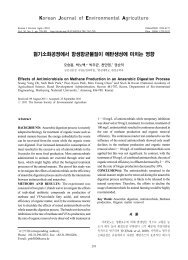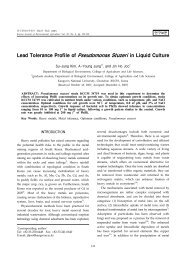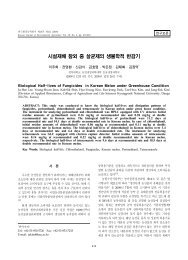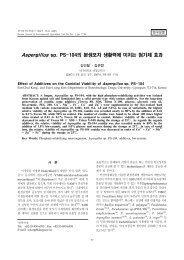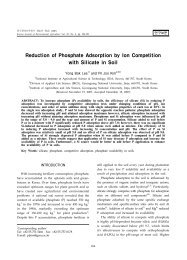Determination of Abamectin Residue in Paprika by High ...
Determination of Abamectin Residue in Paprika by High ...
Determination of Abamectin Residue in Paprika by High ...
You also want an ePaper? Increase the reach of your titles
YUMPU automatically turns print PDFs into web optimized ePapers that Google loves.
360<br />
Wen-M<strong>in</strong>g Xie, Kwang-Yong Ko, Sung-Hun Kim, Hee-Ra Chang, and Kyu-Seung Lee<br />
H 3 O<br />
O<br />
HO<br />
O<br />
O<br />
CH CH 3<br />
H<br />
H CH 3<br />
H<br />
3 C<br />
O<br />
O<br />
H 3 C O<br />
H 3 C<br />
H O O<br />
AVM B 1 a: R=C 2 H 5<br />
AVM B 1 b: R=CH 3<br />
O<br />
formation <strong>of</strong> 8, 9-Z-AVM B 1a. Most AVMs are highly<br />
lipophilic substances and are dissolved <strong>in</strong> most organic<br />
solvents, but are poorly soluble <strong>in</strong> water 3) . In the environment,<br />
AVMs are quickly degraded (half-life,<br />
4-21 h) <strong>by</strong> oxidative and photo-oxidative mechanisms<br />
when exposed to light <strong>in</strong> water on a th<strong>in</strong> biological<br />
surfaces (e.g. leave) or bounded to the soil particles 4) .<br />
The high molecular weight <strong>of</strong> the AVMs (>800<br />
daltons) leads liquid chromatography as the most suitable<br />
chromatographic technique for determ<strong>in</strong>ation. Liquid<br />
chromatographic methods us<strong>in</strong>g ultraviolet (UV)<br />
detection and fluorescence detection for the AVMs<br />
residue <strong>in</strong> different k<strong>in</strong>d samples were reported. Johan<br />
described the determ<strong>in</strong>ation <strong>of</strong> AVMs <strong>in</strong> lettuce and<br />
cucumber <strong>by</strong> high performance liquid chromatography<br />
(HPLC) with UV detector 5) . However, the method was<br />
not sensitive enough (limit <strong>of</strong> detection 40 μg/kg). So,<br />
HPLC with fluorescence detection follow<strong>in</strong>g a fluorescent<br />
derivatization <strong>of</strong> the parent compounds us<strong>in</strong>g<br />
trifluoroacetic acid and a basic catalyst (such as methylimidazole)<br />
has been a common analytical method for<br />
monitor<strong>in</strong>g ABM residues <strong>in</strong> tissue, milk, fruits, and<br />
vegetables 6-10) . Liquid chromatography/tandem mass<br />
spectrometry (LC/MS/MS) analysis was developed<br />
for the determ<strong>in</strong>ation <strong>of</strong> AVMs <strong>in</strong> milk, liver, muscle,<br />
and food commodities 11-15) . The ELISA method was<br />
also used to detect ABM, IVM, and EPR residues <strong>in</strong><br />
bov<strong>in</strong>e liver tissues, with a limit <strong>of</strong> quantization <strong>of</strong> 1.06<br />
ng/mL for all k<strong>in</strong>ds <strong>of</strong> three AVMs 16) .<br />
OH<br />
HO<br />
H<br />
CH 3<br />
H<br />
H<br />
CH 3<br />
R<br />
O<br />
H<br />
CH 3<br />
Of all above methods, fluorescence detection <strong>of</strong>fered<br />
the most specific method with the lowest detection<br />
limit. However, the methods published have been<br />
applied for measurements <strong>in</strong> complex matrices like<br />
plants and animal tissues. The very low concentrations<br />
<strong>in</strong> these tissues required a very laborious procedure<br />
<strong>in</strong>clud<strong>in</strong>g extraction, several clean-up steps, and derivatization<br />
before f<strong>in</strong>al HPLC-fluorescence detection. So<br />
C H 3<br />
CH 3<br />
O<br />
O<br />
OH<br />
HO<br />
CH 3<br />
O<br />
H<br />
CH 3<br />
H<br />
8, 9-Z-AVM B 1 a<br />
Fig. 1. Chemical structures <strong>of</strong> avermect<strong>in</strong> B 1a, , B 1b and<br />
8,9-Z-avermect<strong>in</strong> B 1a.<br />
1a<br />
the ma<strong>in</strong> purpose <strong>of</strong> this study was to develop a rapid,<br />
sensitive, and quantitative technique for the determ<strong>in</strong>ation<br />
<strong>of</strong> AVMs <strong>in</strong> paprika. S<strong>in</strong>ce concentration <strong>of</strong> the<br />
sample extracts <strong>of</strong>ten led to severe <strong>in</strong>terference <strong>by</strong><br />
concurrent co-extracts, rigorous purification <strong>of</strong> sample<br />
extracts must be required. Therefore, this study was<br />
ma<strong>in</strong>ly focused on the development <strong>of</strong> an efficient but<br />
simple analysis method to detect the residual level<br />
and clarification the dissipation patterns <strong>of</strong> AVMs residue<br />
<strong>in</strong> paprika under greenhouse condition.<br />
Sample preparation<br />
EXPERIMENT<br />
The field experiment on paprika was conducted<br />
under greenhouse condition at Bulgok-Myeon, Deajeon<br />
City <strong>of</strong> Korea <strong>in</strong> 2004. The paprika seedl<strong>in</strong>gs were<br />
transplanted <strong>in</strong> the middle <strong>of</strong> June. The plots were<br />
randomly distributed <strong>in</strong> the greenhouse, and the temperature<br />
was kept at 13-33 ℃ and the humidity at 66-<br />
100%. <strong>Abamect<strong>in</strong></strong> (EC, 20% a.i.), was applied as 2000-<br />
time dilute spray with water when mite outbreak was<br />
found <strong>in</strong> September. There were a total <strong>of</strong> three applications<br />
with the <strong>in</strong>terval <strong>of</strong> seven days before the fruits<br />
were sampled for residue analysis after the last application.<br />
Each treatment, <strong>in</strong>clud<strong>in</strong>g control, was replicated<br />
four times <strong>in</strong> a randomized block design. <strong>Paprika</strong><br />
samples were plucked randomly from each treatment<br />
at different time <strong>in</strong>tervals (1, 3, 5 and 7 days). Approximately<br />
500 g <strong>of</strong> the sample homogenate was reta<strong>in</strong>ed<br />
<strong>in</strong> the labeled plastic bags. The samples were stored<br />
at or below -24℃<br />
until analyzed. Before subsampl<strong>in</strong>g<br />
for analysis, the samples were partially thawed and<br />
mixed thoroughly, whenever appropriate to ensure that<br />
a representative sample was aliquoted.<br />
Reagents and equipment<br />
All reagents were analytical quality. Water, methanol,<br />
and acetonitrile (UV and pesticide residue grade)<br />
were obta<strong>in</strong>ed from Burdick & Jackson (Muskegon,<br />
USA). Trifluoroacetic anhydride and 1-methylimidazole<br />
were obta<strong>in</strong>ed from Sigma (St. Louis, MO, USA). The<br />
solid-phase extraction was done with Sep-Pak Vac<br />
silica cartridges (1,000 mg, 8 mL) obta<strong>in</strong>ed from Waters<br />
Associates (Milford, MA).The AVM standard conta<strong>in</strong><strong>in</strong>g<br />
85.5% w/w AVM B 1a and 6.9% w/w AVM B 1b was<br />
obta<strong>in</strong>ed from Syngenta AG NOA. The degradation



